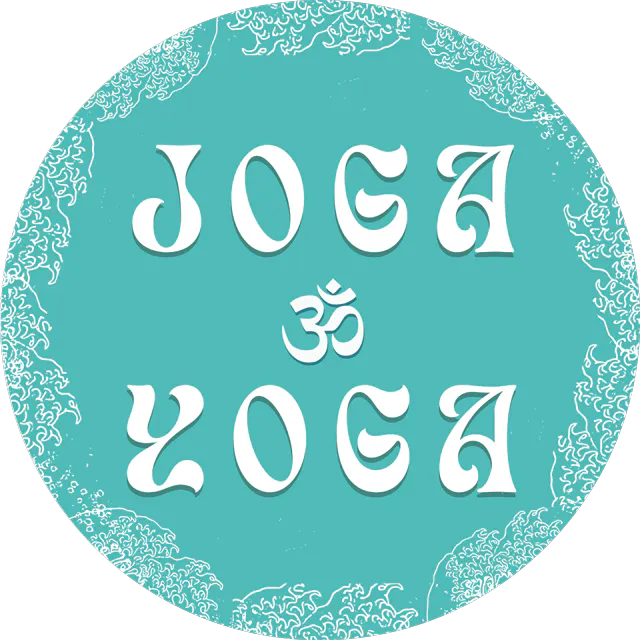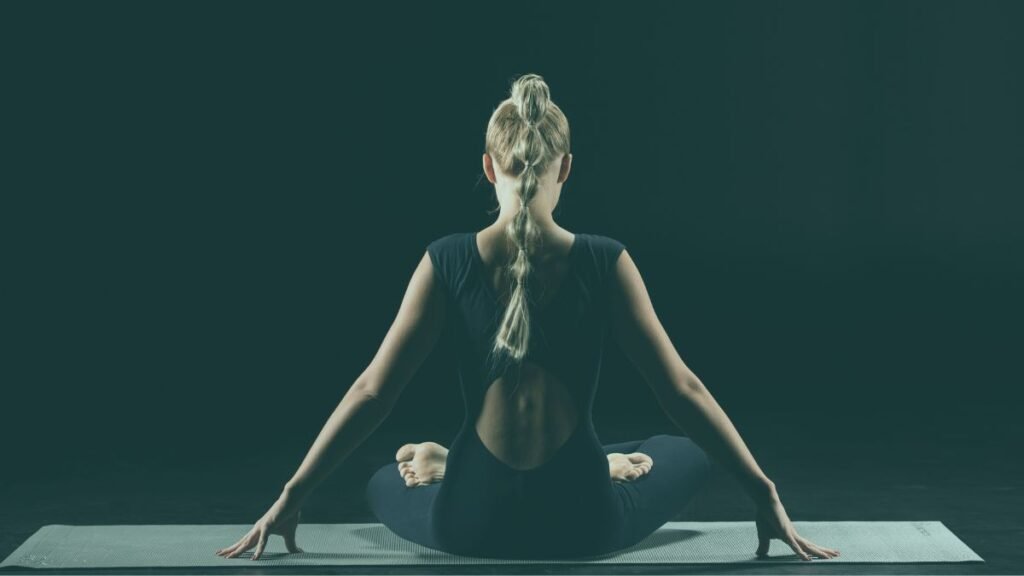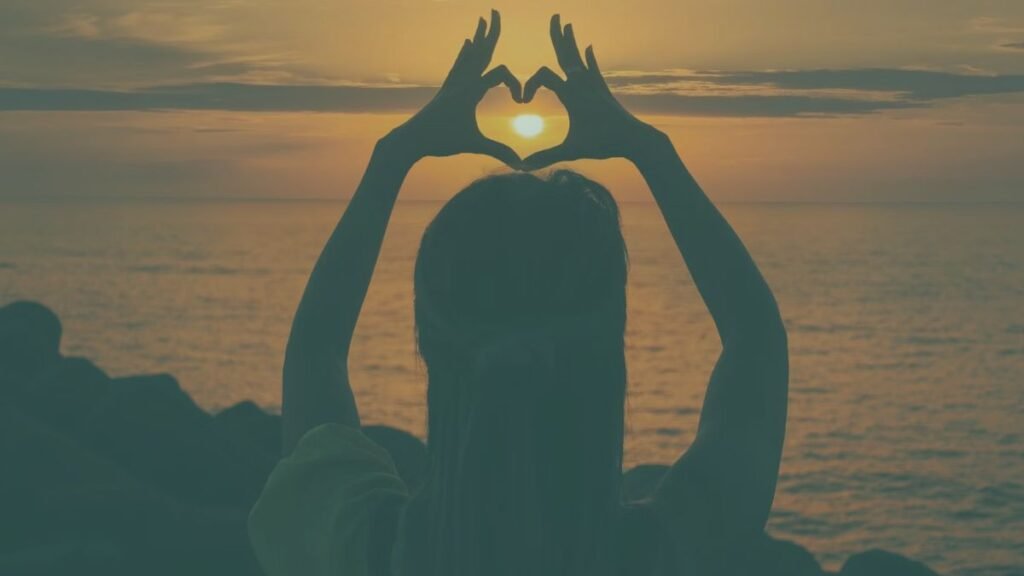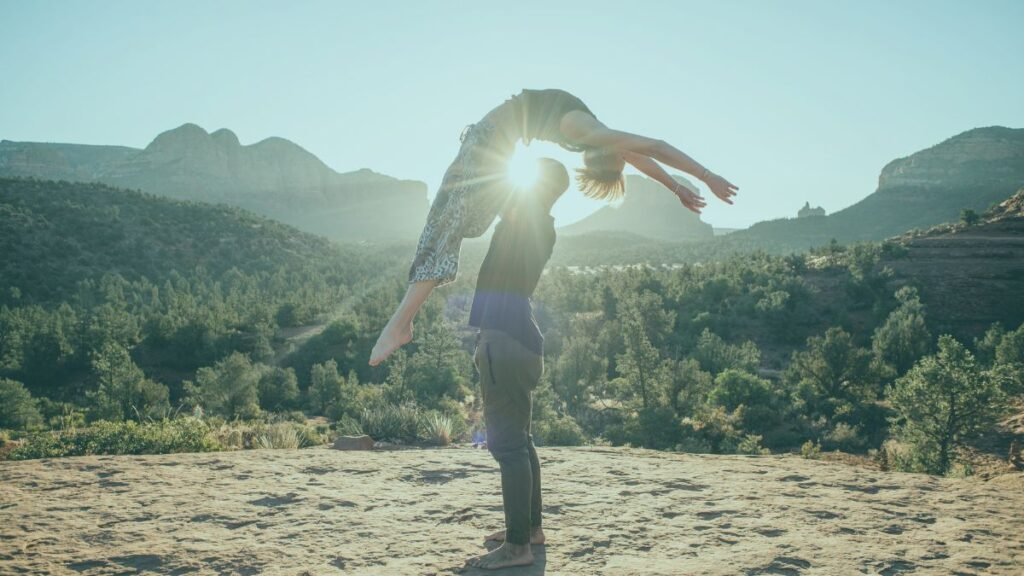Acro yoga combines yoga, acrobatics, and Thai massage into a playful partner practice that builds trust, strength, and flexibility. This guide covers history, benefits, poses, and safety tips.
What is Acro Yoga?
Acro yoga is a partner-based practice that mixes yoga, acrobatics, and Thai massage to build strength, flexibility, and trust.
In acro yoga, you do not move alone; you work closely with one or more partners. Each person has a role:
- Base – The person on the ground who supports the other. They use strong legs and core muscles to keep everything stable.
- Flyer – The person lifted into the air. They balance, move into poses, and stay connected with the base through trust and control.
- Spotter – The safety helper. They stand nearby to guide movements, prevent falls, and make sure everyone feels safe.
This is not just about “flying,” it is about teamwork, communication, and paying attention to each other’s movements. You might also hear people call it partner yoga, aerial yoga, or acroyoga practice.
How Did Acro Yoga Start? (History & Evolution)
Acro yoga grew from traditional yoga, circus-style acrobatics, and healing practices over many decades.
- In 1938, the father of modern yoga, T. Krishnamacharya, was photographed doing a backbend with a child balanced on him. This was not called acro yoga yet, but it showed the roots of partner-based movement.
- In the 1980s, Benjamin Marantz developed AcroSage, a mix of massage and inverted poses. This inspired many of the flying positions used in modern classes.
- In 1999, dancers Euguen Poku and Jessie Goldberg started AcroYoga Montreal, blending dance, acrobatics, and yoga into a flowing style.
- In 2003, Jason Nemer and Jenny Sauer-Klein launched AcroYoga International. They built a teacher training program so the style could spread worldwide.
Why Acro Yoga Is Unique
Acro yoga blends physical skill, mindfulness, and partnership in a way most other yoga styles do not.
It is not the same as traditional yoga, which focuses on solo postures, or partner yoga, which is often slower and closer to the ground. Acro yoga adds lifts, balancing moves, and transitions that challenge strength and coordination.
It combines three elements:
- Strength training to hold and balance poses
- Playfulness to explore movement and creativity
- Mindfulness to stay connected and present with your partner
Because of the trust needed between the base, flyer, and spotter, the practice builds a strong sense of teamwork and community.
Key Roles in Acro Yoga
Acro yoga has three main roles, each with a different focus and responsibility.
- Base: The base is the foundation of every pose. They lie or stand firmly, using strong legs and core muscles to support the flyer.
Pro tip: Keep your feet flexed and your core tight to stay steady. - Flyer: The flyer is the person lifted into the air. They use balance, core strength, and smooth movements to create and hold poses.
Pro tip: Keep your gaze fixed on one point to help with balance. - Spotter: The spotter is the safety guide. They stand nearby to help with balance, guide movements, and prevent falls.
Pro tip: Stay close, watch both base and flyer, and use clear words when giving instructions.
What Happens in a Typical Acro Yoga Class?
A class moves in stages to warm you up, teach partner skills, and help you end safely.
- Opening Circle – Everyone gathers to set goals and connect.
- Warm-up and Conditioning – Light stretches and joint movements prepare the body.
- Partner Flow – Simple partner stretches and easy lifts to build trust.
- Main Poses – Instructor teaches poses suited to your level, from beginner to advanced.
- Cool Down – Slow stretches and breathing to relax and close the session.
What to bring:
- Yoga mat or padded surface
- Comfortable, fitted clothes that allow movement
- Water bottle
- Small towel
- Open mind and patience
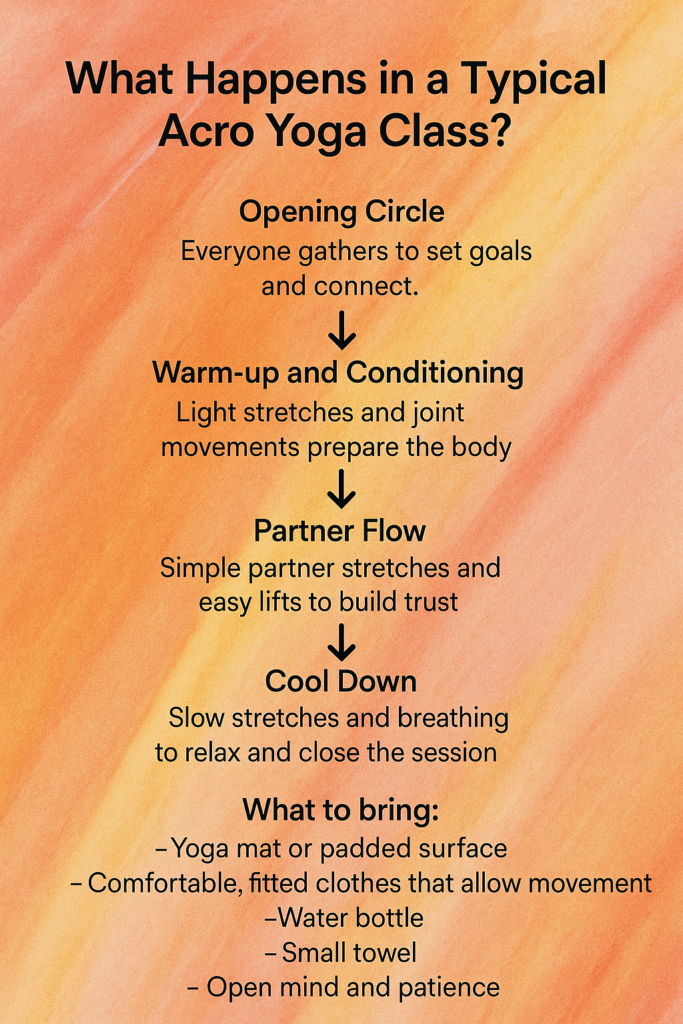
Health and Wellness Benefits of Acro Yoga
Acro yoga improves your body, mind, and relationships all at the same time.
Physical benefits:
- Spinal decompression from inverted poses helps reduce back pressure.
- Core strength builds from balancing and supporting your partner.
- Flexibility improves as you move through a wide range of positions.
- Trust grows as you rely on your partner for balance and safety.
- Communication skills improve through constant verbal and non-verbal cues.
- Mindfulness develops as you stay focused on each movement.
Social benefits:
- Bonding happens naturally through shared challenges.
- Community engagement comes from group practice and shared learning.
Fun fact: Studies show that individuals who exercise with a partner are 32% more likely to reach sufficient physical activity compared to those who work out alone (source: NIH).
Safety Rules Before You Start
Following safety rules helps you enjoy acro yoga without unnecessary risks.
- Always work with a spotter when learning new poses.
- Warm up before class and cool down afterward to protect muscles and joints.
- Avoid acro yoga if you have: high blood pressure, recent injury or surgery, vertigo, joint problems, open wounds, or if you are pregnant.
How to avoid common mistakes:
- Do not skip warm-ups.
- Start with easy poses before moving to advanced ones.
- Communicate clearly before and during transitions.
- Switch roles often to build balanced skills.
Can You Do Acro Yoga at Home?
Yes, but only if you have the right partner, space, and safety plan.
It is safe at home if you already know basic techniques and have an experienced partner. If you are new, start with a certified instructor first.
Home setup checklist:
- Yoga mat or crash pad for cushioning
- Open space with no furniture or sharp edges
- Experienced partner
- Safety spotter
Even at home, always work slowly, keep talking to your partner, and stop if something feels unsafe.
Beginner-Friendly Acro Yoga Poses (Step-by-Step)
These poses are perfect for new acro yoga students who want to build trust, balance, and body control.
1. Stacked Plank Pose
Difficulty: Easy
Target muscles: Core, shoulders, arms
Safety note: Keep wrists straight and core tight to avoid strain.
How to do it:
- Base starts in a plank position with shoulders over wrists.
- Flyer stands behind the base, places feet carefully on the base’s shoulders, and stacks their own plank position on top.
- Hold for a few breaths, then step down slowly.
2. Fish on the Rocks
Difficulty: Easy
Target muscles: Lower back, chest, hips
Safety note: Move slowly into position to avoid sudden weight shifts.
How to do it:
- Base sits in Child’s Pose with knees wide and arms stretched forward.
- Flyer lies on their back over the base, arching slightly to open the chest.
- Relax and breathe together.
3. Partner Forward Fold
Difficulty: Easy to Moderate
Target muscles: Hamstrings, lower back
Safety note: Do not force the stretch; keep backs straight.
How to do it:
- Stand back-to-back with your partner.
- Hook elbows together.
- Base leans forward, lifting the flyer onto their back.
- Hold the stretch, then slowly return upright.
4. Front Plank (Airplane Pose)
Difficulty: Moderate
Target muscles: Core, legs, shoulders
Safety note: Spotter is important for stability in the first attempts.
How to do it:
- Base lies on their back with knees bent and feet on flyer’s hips.
- Flyer leans forward, holding hands with the base.
- Base straightens legs until the flyer is parallel to the floor.
5. Folded Leaf Pose
Difficulty: Moderate
Target muscles: Back, hips, shoulders
Safety note: Keep a soft bend in the base’s knees to avoid strain.
How to do it:
- Base lies on their back with feet on flyer’s hips.
- Flyer leans forward, allowing upper body to drape down toward the base’s legs.
- Base holds flyer’s arms or wrists for support.
Intermediate and Advanced Poses to Try Later
These poses need more balance, strength, and trust, so only try them with a certified teacher and a spotter.
1. Star Pose
- Focus: Core stability, balance, shoulder strength
- How it looks: Flyer balances on the base’s hands with legs spread wide like a star.
- Safety: Keep communication constant. Spotter should be ready to guide the flyer’s hips.
2. Shoulder Stand on Hands
- Focus: Upper body strength, inversion control
- How it looks: Flyer balances upside down with shoulders resting in the base’s hands.
- Safety: Practice against a wall first. Spotter stands behind the flyer to prevent falls.
3. Reverse Star
- Focus: Back strength, chest opening, partner timing
- How it looks: Flyer faces upward while the base supports them by the hips or lower back, creating a reverse star shape.
- Safety: Keep legs engaged and core tight to protect the lower back.
Practice Tips to Improve Faster
A few smart habits can help you get better at acro yoga safely and quickly.
- Build trust first: Spend time on easy poses so you and your partner learn each other’s timing.
- Switch roles often: Experience both base and flyer to improve balance and body awareness.
- Use progressive training: Start with low lifts and simple moves before adding height or complexity.
- Record your practice: Video helps you see mistakes and fix your form.
Conclusion and Your Next Step in the Acro Yoga Journey
Acro yoga is more than just exercise. It builds strength, trust, and connection through playful partner poses. You develop physical skills, learn teamwork, and join a community of people who value movement and mindfulness.
If this sparked your curiosity, the best way to deepen your skills and explore acro yoga safely is through guided training. Joga Yoga in Bali offers Yoga Alliance–certified teacher training that includes hands-on partner work, anatomy training, and safe spotting techniques.
With 200+ hour programs, small class sizes, and an inspiring Bali setting, you get personal guidance from experienced instructors while enjoying a supportive community. Even if you are not ready for full certification, you can join their daily yoga classes in Canggu to build your foundation.
Explore Joga Yoga Teacher Training in Bali or check the Yoga Classes in Canggu to start your journey.
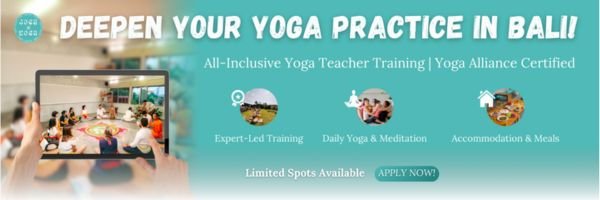
FAQs About Acro Yoga
Is acro yoga safe for beginners?
Yes, if you start with a certified teacher and a spotter. Begin with simple poses and focus on safety before trying harder moves.
Do I need to be flexible to start?
No, you can start at any flexibility level. The practice will naturally improve your range of motion over time.
Can kids do acro yoga?
Yes, but they should work with experienced instructors and always have a spotter for safety.
How is it different from aerial yoga?
Aerial yoga uses a hammock or fabric for support. Acro yoga uses a human partner for lifts, balance, and movement.What muscles does acro yoga work?
It works the core, legs, shoulders, arms, and back while also training balance and coordination.
